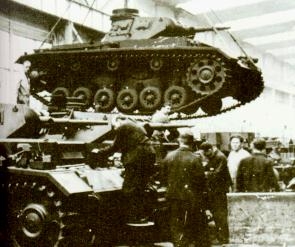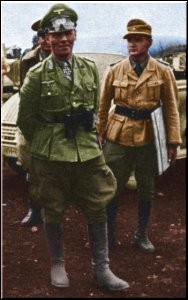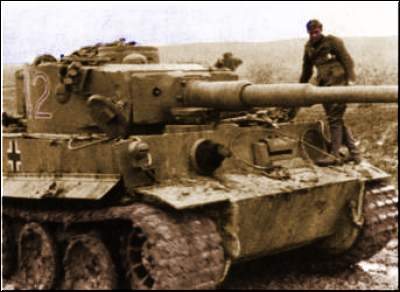
by COL Scott Pritchett
Germany’s war in North Africa began on 12 February 1941 with the
arrival of Rommel’s staff (Aufklärungsstab Rommel) in Tripoli, Libya and
ended two years later on 13 May 1943 with the final surrender of
Heeresgruppe Afrika in Tunisia. The intervening twenty-seven months of
combat operations, and the almost 300,000 Wehrmacht soldiers who fought
the battles and campaigns, chronicle a unique part of warfare in WWII.
The desert campaigns that swept across the expanses of North Africa and
see-sawed back and forth on land, at sea and in the air were hard fought
between enemies who, despite the intensity of the combat, still managed
to display a peculiar chivalry that was unknown on other war fronts –
even between the same foes. North Africa was a complex theater.
While the Deutsches Afrika Korps (DAK) and Rommel typically tend to
embody the forces that fought in this theater, the war in North Africa
was in fact a Wehrmacht effort undertaken by the combined armed services
of the Heer (not all of which was part of the Afrika Korps), the
Luftwaffe, and the Kreigsmarine. To detail all the battles and campaigns
is beyond the scope of article, and would be a work in itself. Numerous
books have been written on the this theater are still widely available
to the collector-historian. However, some background is needed in order
to set the context for appreciating the unique awards and insignia that
came to represent the laurels of the Wehrmacht soldier, sailor and
airman who fought in this theater, one of which was the AFRIKA cuffband.

CAMPAIGN HISTORY
The armistice with France in 1940 left England alone against the Axis powers. The Germans’ options for carrying the war to the British isle were limited to amphibious and air attack. However, with the abandonment of OPERATION SEA LION - the amphibious invasion of the island - and the Luftwaffe’s faltering air campaign in the Battle of Britain, Germany began looking for other means to pressure the English and drive them out of the war. The different branches of the Wehrmacht developed varying estimates of the situation and thus, held differing opinions of how this might be done. One of several courses of action widely considered was supporting the Italian army in North Africa with an armored force. But the Italians, out of pride, an unfounded confidence, and an unrealistic assessment of their capabilities, initially shunned any German support. While providing German forces also evinced little enthusiasm by the OKW, by August of 1940 the OKH had decided make its own determination regarding the status of the situation in the theater. General Ritter von Thoma made a reconnaissance and, by October 1940, was reporting back that conditions were not good for Germany to provide even limited support to the Italians. In the mean time, the idea of carrying the war into the Mediterranean was seized upon by the Kriegsmarine. Großadmiral Erich Reader made a forceful case for reinforcing the Italians, as much to prevent them from controlling the Mediterranean as to push the British out. The level of involvement, which continued to be planned on a small scale – satisfying neither the OKH nor the OKM – became overshadowed by the planning for the invasion of the Soviet Union and mired by the Italian’s unannounced invasion of Greece (see the article on the KRETA cufftitle for more on this campaign). Inevitably, and without a coherent, unified strategy, events in the Mediterranean Theater began to draw in German forces. The Luftwaffe, in particular, was sent in December 1940 to occupy bases in Italy in order to attack British shipping and ports, such as the strategically important island of Malta. Simultaneously, on 10 December 1940, the British began a surprise counteroffensive against the beleaguered Italians from Egypt. In just seven days the Italians were completely routed and in rapid retreat west through Libya. By 19 December 1940, the Italians were emphatically seeking German assistance to save the situation. Again, it was the Luftwaffe, in the form of the X Fliegerkorps, who led the German response. By early January 1941, as Tobruk fell to the British-Commonwealth forces, the Germans decided to make a large commitment of troops in order to block the British advancing to Tripolitania and prevent a complete Italian collapse. By 14 February, the first of Rommel’s panzer troops were arriving in Tripoli. However, the British conquered Cyrenaica by 8 February, leaving only a thin line of beaten Italian troops between them and the port of Tripoli. With barely a pause to pass in review before Rommel and the Italian command as they disembarked in Tripoli, the lead elements of the 5. Leichte Division moved east to make contact with the British. The lengthy search for a way to carry the fight to the British finally ended with the first contact between Aufklärungs 3 and 33, which formed “Advance Unit Wechmar”, and a troop of the British Dragoon Guards. The British lost in this initial, losing 5 vehicles and one soldier killed. The Germans suffered no casualties, and even managed to capture a few British vehicles.
Most of the next sixteen months of the war in North Africa were characterized by both sides being locked in to a back and forth series of operations across the expanses of Cyrenaica, Libya and Western Egypt. It was warfare fought around lines of communication and battles that surged and ebbed around supplies and combat losses.
There were a number of interesting aspects to the fighting. Throughout the war the Allies were able to read all of the German's traffic through ULTRA - an advantage the Germans were neither aware of nor able to enjoy in reciprocation until late 1941 when German signals personnel were able to intercept and read allied communications. The German advantage only lasted until the summer of 1942 when the Allies were able to destroy this intercept unit. But the Germans' superior ability to mass the various arms of service in combined arms operations often offset or dominated the British's ability to read Rommel's plans. Another point of interest was that whereas Rommel's career, rank and span of command only increased in stature, regardless of the see-saw fortunes of battle, the careers of multiple British commanders ended with each failure to best Rommel. And, although a somewhat insignificant footnote, but perhaps nonetheless interesting to the collector-historian, the Germans tended to name battles after the main terrain feature or city around which the main fight occurred. The British tended to name battles as operations, independent of locations, by using code words. Thus, the German's "Battle of Sollum" in June 1942, was the British's "Operation Battleaxe".
Rommel's early success convinced him that he had caught the British off balance. Consequently, in a series of lightening strokes he drove his combined German and Italian forces east to capture El Agheila, Benghazi and El Mechilli, reversing in just under two weeks what had taken the British almost two months to achieve. By 12 April 1941 he was attacking Tobruk, an important port of supply for British forces. However, Rommel's lines of communication had become stretched. For over a month he besieged the port, unable to seize it in a series of attacks that sought to find a weakness in its defenses. By mid May, the British, under Wavell counterattacked in Operation Brevity and, later in June, a second attack came with Operation Battleaxe. It was in this latter battle that Rommel forever linked the German 88mm with fame as a direct fire, anti-tank gun.
 >
>
Exhausted and depleted, neither side was able to continue offensively and, from July 1941 to November 1941, each side hastened to refit and reorganize. It was during this period that the 5. Leichte Division upgraded to a full panzer division, becoming the 21. Panzer Division. As it was to usually turn out, Rommel was ready first. However, with the advantage of ULTRA the British, now under Cunningham (Wavel was relieved after the failures of Operations Brevity and Battleaxe), preempted his attack by launching Operation Crusader on 17/18 November 1941. The Germans came to know this period as the "Winter Battles", and for nearly a month outfought the British forces who repeatedly failed to mass their armor against the outnumbered panzers. Battles at Sidi Rezegh, Belhamed, El Duda and Fort Capuzzo, as well as continued assaults against Tobruk marked this period of fighting in the North African war. Once again Rommel saw an opportunity to strike the British when they were off balance. This time he collected the Afrikakorps and attacked past the British 8th Army in an attempt to strike a fatal blow to their lines of communication and rear areas. However, rather than the 8th Army withdrawing forces away from the front, Auchinleck - its new commander who had relieved a shaken Ritchie - counterattacked to recover the terrain they had lost to the Germans. Refusing to be outflanked and rolled up, Rommel decided to withdraw to El Agheila but was not aggressively pursued by his adversaries. Unfortunately, as he would demonstrate on several occasions, Rommel left German and Italian forces behind. This time at both Halfaya and Bardia, where they were eventually forced to surrender, in spite of a bravely fought defense.
These disappointing results followed the German-Italian forces in to 1942 marked the beginning of another period where each side tried hurried to resupply and refit forces. Again, Rommel was ready first and this time conducted a successful attack that took the Axis forces, by the end of January 1942, to Gazala, a point roughly half way between the Axis base of operations in Tripoli and the Allies' base in the Nile Delta. But here again Rommel could move no farther, hobbled by supply problems that were aggravated as much by events elsewhere, such as the British retention of Malta and the severe first winter on the Eastern Front, as by events in his own area of operations. It was not until 26 May 1942 that the German-Italian forces were again on the attack. The Axis plan was slow to develop primarily because Rommel, using the Luftwaffe, the 90th Light Division and the Italian Ariete Armored Division, was unable to quickly defeat the Free French forces defending Bir Hacheim in his rear. But he drove the combined German-Italian forces relentlessly and, by late June, was turning the British out of the Gazala Line of defense. Tobruk, ever the thorn in Rommel's side, presented itself again as an objective that must be seized. This time Rommel was finally successful and accepted the surrender of the South African commander on 21 June 1942.
Almost immediately, Rommel issued the order to attack in to Egypt toward the Nile Delta for what he saw as perhaps his best chance to finish the British and Commonwealth forces. This move forced the Luftwaffe to move east with him, taking the British at Malta - the most significant threat to Rommel's supply lines - out of its range. Simultaneously, Luftwaffe forces in Sicily were reassigned and shifted to support the Germans' thrust in to the Soviet Caucasus. Yet, this moment found Rommel at the height of his achievement: in command of Panzerarmee Afrika and, at 50 years of age, promoted as the youngest Feldmarschall in the Wehrmacht. Relentlessly pushing his troops (the 21. Panzer Division was down to less than 1,000 troops and 23 tanks for example), he defeated a British Commonwealth force much larger than his exhausted Panzerarmee at Mersa Matruh. The only thing remaining in front of Rommel was an as yet unevaluated piece of terrain in a narrow neck of land between the sea and an intractable patch of desert known as the Quatara Depression. This was the El Alamein Line. For the next four months, between July and October 1942, both sides fought around this static position. However, as in the past, the fighting was characterized by the cyclic build up of forces (Rommel received the 164th Light Division, the Ramcke Brigade and gliders to augment his overworked Ju-52 transport force) and another change of command on the Allied side (Auchinleck was replaced by Montgomery).

It was during this period that Rommel’s health suffered significantly, so much so that his battle command also suffered at times through hesitation and a lack of his characteristic drive. His illness eventually forced him to return to Germany on 23 September 1942 to convalesce. But Rommel returned on 25 October 1942, two days after Montgomery opened his El Alamein offensive. Morale in Panzerarmee Afrika remained high – particularly with Rommel’s return - and the Germans continued to best their adversary for a week, albeit at a high price. The British were grinding the Germans down. With the aide of ULTRA (which in particular was reading the German and Italian logistic reports), and a significant superiority in numbers of men, artillery and tanks, Montgomery pressed the attack, knowing full well that Rommel’s forces would eventually give out before his own. By the night of 2/3 November 1942 the Panzerarmee was on the verge of withdrawing, but stopped when confusing communication signals led Rommel to believe he had been ordered to hold at all costs. The British, reading the same signals, drew the same conclusion and slowed their attack, expecting renewed stiffness in the German’s battle line. However, by 4 November Kesselring convinced Rommel that he had read the order incorrectly, and the retreat was on. Three days later the Allies executed Operation Torch, the invasion of North Africa and the Germans were now faced with converging attacks. Again, German skill coupled with Montgomery’s plodding advance contributed to Rommel fighting a brilliant withdrawal to the eastern Tunisian border. Halting throughout November 1942 at El Agheila, Buerat and Hom, Panzerarmee Afrika was also assisted by the fact that Operation Torch had been executed too far to the west to immediately bring pressure on the Germans facing Montgomery. But retreat was all Rommel could do, as his dwindling forces repeatedly sought defensible terrain.
After finally abandoning Tripoli in January 1943, the Panzerarmee arrived at the Mareth Line early in February 1943. The Germans had won the race to defend Tunisia. Additionally, within two days of the Torch landings, the Germans' 5th Panzer Armee began arriving in Tunis under the command of Generaloberst von Arnim. Feldmarschall Kesselring assumed overall command of the theater, but because of the awkward and complex command structure also became the de facto ground commander of the two armies in Tunisia (with Panzerarmee Afrika now being renamed as the 1st Italian Armee). The final phase of the German's war in North Africa now began. The first combined action between the two armies took place in mid-February at Sidi Bou Zid where the Americans were given a sharp defeat. As compensation for a rapidly deteriorating supply situation, the Germans now at least enjoyed interior lines of communication between the forces fighting east and west against the converging Allies. However, the lack of unity of command within the German forces began to have an impact. At odds with one another, von Arnim's and Rommel's disagreements resulted in delays the Germans could ill afford. The compromise that was eventually worked out gave Rommel command over von Arnim's forces and the German victory at Kasserine Pass. But the delays brought about by the debate over command and strategy allowed the Allies time to coordinate. Subsequent efforts by the Germans, hampered by supply, disadvantaged by ULTRA and pressured by overwhelming Allied numbers became little more than delay tactics. Rommel was brought out of the collapsing North African war (as were many highly experienced senior officers) and returned to Germany on 9 March 1943. Generaloberst von Arnim assumed overall command and General von Vaerest took over 5th Panzer Armee.
The tenacity of the German soldier prolonged the fight in to May 1943. On 6 May, the Allies began a powerful attack towards Tunis and the German front split open. Bizerte fell to the Americans on 7 May and Tunis a day later to the British. In a poignant irony, the last transmission sent to the OKW from German forces in North Africa was sent by the last commander of the Afrikakorps, General Cramer. By this point in the war, the Afrikakorps was but a small part of the overall German forces engaged - but still its heart and sole nonetheless. This message read: "Ammunition expended. Arms and equipment destroyed. In accordance with orders received the Afrikakorps has fought itself to a condition where it can fight no more. The German Afrikakorps must rise again. Heia Safari." Shortly thereafter, on 13 May 1943, the war in North Africa ended.
![]()
© Copyright Wehrmacht-Awards.com LLC |